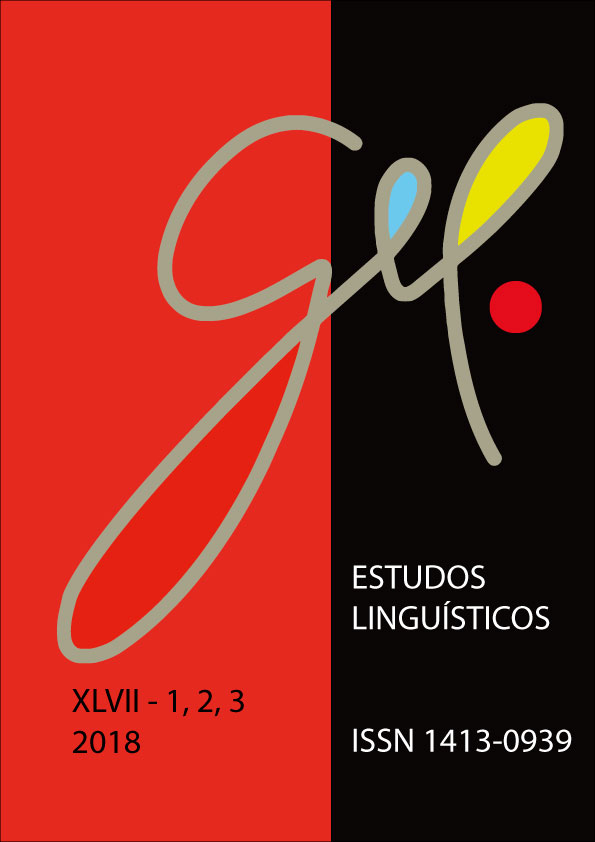Variação semântica e a noção de Hierarquia Funcional-Conceitual
DOI:
https://doi.org/10.21165/el.v47i1.2011Palavras-chave:
hierarquia funcional-conceitual, variação semântica, preposiçõesResumo
Dentro da Nanossintaxe, a variação no comportamento sintático-semântico de distintas classes é explicada pelo fato de que línguas diferentes codificariam partes distintas de sequências funcionais hierárquicas em diferentes itens lexicais. Essas sequências seriam, por sua vez, construídas a partir de conceitos primitivos muito mais finos do que as categorias sintáticas tradicionais e se aproximariam de uma decomposição semântico-conceitual como a proposta de Jackendoff (1983, 1990, 1997). Para diversos autores (STARKE, 2010, 2011; CAHA, 2009; PANTECHVA, 2011), a questão da variação se reduziria, então, à diferença no tamanho das estruturas estocadas em diferentes itens do léxico. Este trabalho apresentará, assim, uma discussão sobre a relevância da aplicação da noção de hierarquia funcional-conceitual na análise das preposições do português brasileiro.Downloads
Referências
CAHA, P. Case movement in PPs. Nordlyd, v. 34, n. 2, p. 240-299, 2007.
CAHA, P. The case hierarchy as functional sequence. In: RICHARDS, M.; MALCHUKOV, A. L. (Eds.). Scales. LINGUISTISCHE ARBEITS BERICHTE 86, p. 247-276, Universität Leipzig. 2008. Disponível em: <http://www.uni-leipzig.de/~asw/lab/lab86/LAB86_Caha.pdf>. Acesso em: 10 jan. 2017.
CAHA, P. The nanosyntax of case. 2009. 334 f. Tese (Doutorado em Linguística) – University of Tromsø, Tromsø, 2009.
CAHA, P. Spell-out (Morphosyntax). Bruxelas, Bélgica, 7-11 abril 2014. Minicurso ministrado na First Glow Spring School (GSS1): ‘Theories in Dialogue’. Generative Linguistics in the Old World – GLOW 37.
CASTILHO, A. T. O problema da gramaticalização das preposições no Projeto Para a História do Português Brasileiro. Estudos linguísticos XXXIII, v. 33, p. 982-988, 2004. Disponível em: <http://www.gel.org.br/estudos-linguisticos/edicoes.php>. Acesso em: 10 jan. 2017.
ECKARDT, R. Meaning change in grammaticalization: an enquiry into semantic reanalysis. New York: Oxford University Press, 2006.
FÁBREGAS, A. An argument for phrasal spell-out: Indefinites and interrogatives in Spanish. Nordlyd, v. 36, n. 1, p. 129-168, 2009.
FÁBREGAS, A. The exhaustive lexicalisation principle. Nordlyd, v. 34, n. 2, p. 165-199, 2007.
FILLMORE, C. J. The case for case. In: BAHC, E.; HARMS, R. (Eds.). Proceedings of the Texas Symposium on Language Universals. April. 1967. p. 1-90. Disponível em: <https://eric.ed.gov/?id=ED019631>. Acesso em: 10 jan. 2017.
GRUBER, J. F. Studies in lexical relations. 1965. 305 f. Tese (Doutorado em Letras Modernas e Linguística) – Massachusetts Institute of Technology, Cambridge, 1965.
JACKENDOFF, R. Your theory of language evolution depends on your theory of language. In: LARSON, R. K.; DÉPREZ, V.; YAMAKIDO, H. (Eds). The evolution of human language: Biolinguistic perspectives. Cambridge: Cambridge University Press, 2010. p. 63-72. Disponível em: <http://ase.tufts.edu/cogstud/jackendoff/papers/languageevolution.pdf>. Acesso em: 10 jan. 2017.
JACKENDOFF, R. Foundations of Language. New York: Oxford University Press, 2002.
JACKENDOFF, R. Semantic Structures. v. 18. Cambridge: MIT Press, 1990.
JACKENDOFF, R. Semantics and Cognition. Cambridge: MIT Press, 1983.
JACKENDOFF, R. The architecture of the language faculty. Cambridge: MIT Press, 1997.
PANTCHEVA, M. B. The syntactic structure of locations, goals, and sources. Linguistics, 48, n. 5, p. 1043-1081. 2010.
PANTCHEVA, M. B. Decomposing Path: The Nanosyntax of Directional Expressions. 2011. 301 f. Tese (Doutorado em Linguística) – University of Tromsø, Tromsø, 2011.
PERLMUTTER, D. M. Impersonal passives and the unaccusative hypothesis. In: BLS 4: General Session. Annual meeting of the Berkeley Linguistics Society, v. 38, p. 157-189, 1978. Disponível em: <http://journals.linguisticsociety.org/proceedings/index.php/BLS/article/view/2198>. Acesso em: 10 jan. 2017.
RAMCHAND, G. Verb meaning and the lexicon: A first phase syntax. Cambridge: Cambridge University Press, 2008a.
RAMCHAND, G. Lexical items in complex predications: Selection as underassociation. Nordlyd, v. 35, n. 1, 2008b.
RAMCHAND, G. Minimalist semantics. In: BOECKX, C. (Ed.). The Oxford Handbook of Linguistic Minimalism. Oxford: Oxford University Press, 2011. p. 449-471.
RAMCHAND, G.; SVENONIUS, P. Deriving the functional hierarchy. Language Sciences, v. 46, p. 152-174, 2014.
SOARES, E. C.; MENUZZI, S. M. Introduzindo e problematizando papéis temáticos e hierarquias temáticas: uma questão de interfaces. Signo, v. 35, n. 59, p. 13-43, 2010.
SON, N.; SVENONIUS, P. Microparameters of cross-linguistic variation: Direct motion and resultatives. In: ABNER, N.; BISHOP, J. (Eds.). Proceedings of the 27th west coast conference on formal linguistics. Somerville, MA: Cascadilla Proceedings Project, 2010. 388-396. Disponível em: <https://pdfs.semanticscholar.org/07b6/c9b64242b8a94763a 9a40d739e838bad4e8f.pdf>. Acesso em 10 jan. 2017.
STARKE, M. Nanosyntax: a short primer to a new approach to language. Nordlyd, v. 36, n. 1, p. 1-16. 2010.
STARKE, M. On the inexistence of specifiers and the nature of heads. In: BELLETTI, A. (Ed.). Structures and Beyond: The Carthography of Syntactic Structures. Oxford: Oxford University Press Inc., 2004. p. 252-268.
STARKE, M. Towards an elegant solution to language variation: Variation reduces to the size of lexically stored trees. Não publicado. 2011. Disponível em: <http://ling.auf.net/lingbuzz/001183/current.pdf>. Acesso em: 10 jan. 2017.
SVENONIUS, P. Spatial P in English. In: CINQUE, Z.; RIZZI, L. (Eds.). Mapping spatial PPs: The cartography of syntactic structures, v. 6, p. 127-160, 2010.
SVENONIUS, P. The emergence of axial parts. In: SVENONIUS, P.; PANTCHEVA, M. (Eds.). Nordlyd, Tromsø Working Papers in Language & Linguistics: 33.1, Special Issue on Adpositions, p. 49-77. University of Tromsø, Tromsø, 2007. Disponível em: <http://www.ub.uit.no/baser/nordlyd/>. Acesso em: 10 jan. 2017.
TRAUGOTT, E. C.; DASHER, R. B. Regularity in semantic change. New York: Cambridge University Press, 2004.
ZWARTS, J. A hierarchy of locations: Evidence from the encoding of direction in adpositions and cases. Linguistics, v. 48, n. 5, p. 983-1009, 2010.
ZWARTS, J. Priorities in the production of prepositions. In: ASBURY, A.; DOTLACIL, J.; GEHRKE, B.; NOUWEN, R. (Eds.). Syntax and Semantics of Spatial P. Amsterdam: John Benjamins Publishing Co., 2008. p. 85-102.



